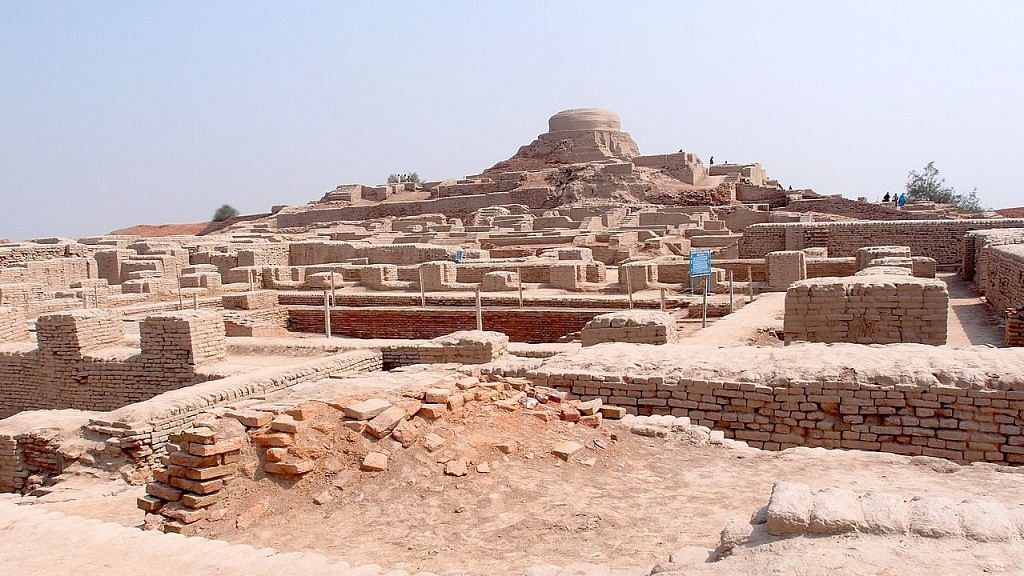Chennai: As Pakistan battles a devastating monsoon, workers at the ruins of Mohenjo-daro – one of the two main centres of the ancient Indus Valley civilisation, also known as the Harappan civilisation – are busy fending off rainwater seeping in and carving channels into this archaeological site.
With torrential rains coming down hard on the country’s Sindh province, open air heritage sites are especially becoming hard to protect. Earlier this week, reports in the Pakistani media showed workers pumping stagnant water from excavated trenches at Mohenjo-daro and scrambling to reinforce the retaining wall of the mound. On 28 August, ‘Mound of the dead,’ one of the site’s most iconic features, was seen covered in tarpaulin.
Excavations at the site of Mohenjo-daro were first recognised in 1922, a year after the discovery of the site of Harappa. Upon digging, it was revealed that the mounds contained the remains of what was once part of a civilisation that came up on the banks of the river Indus, between 2500-1700 BCE.
It was the same river that last month breached its banks and caused unprecedented destruction in Pakistan. Government and welfare organisations have attempted to provide relief and rehabilitate thousands of people, who have been left homeless due to the catastrophic monsoon showers.
The sites of the Indus civilisation – which were among the most prized excavations of Archaeological Survey of India – fell under Pakistan’s territory following the partition of India. Reports suggest that across the province, various forts, tombs and heritage sites that symbolise the glorious past of the region are now in danger of crumbling due to floodwaters.
According to reports, the rainwater at Mohenjo-daro has “damaged excavated areas and exposed the ones buried underneath by creating furrows in them”. Further, the report noted “the accumulated water has seeped into the excavated areas, loosening the soil and resultantly tilting the walls.”
While catastrophic rainfall is threatening to destroy this ancient site, a 2018-study titled ‘Neoglacial climate anomalies and the Harappan metamorphosis’ had suggested that climate change may have led to the decline of the Indus civilisation. The study stated that first, a wetter winter monsoon may have led to urban Harappan society turning into a rural one, as inhabitants migrated from a summer flood-deficient river valley to the Himalayan plains. Later, a decline in winter monsoon could have played a role in the demise of the rural late Harappans.
Impressive structures at Mohenjo-daro
The impressive site of Mohenjo-daro was designated a UNESCO World Heritage Site in 1980. The city of Mohenjo-daro sits about 3 km from the Indus river, from which it seems to have been protected using artificial barriers. Archaeologists have been awed by Indus Valley sites for its sophisticated structures that showed intelligent urban planning.
At Mohenjo-daro, these artificial barriers have been laid out with remarkable regularity into something like a dozen blocks, or “islands,” each about 1,260 feet (384 metres) from north to south and 750 feet (228 metres) from east to west, subdivided by straight or dog legged lanes, according to Britannica. While buildings on the high summit included an elaborate bath or tank surrounded by a veranda, a large residential structure, and a massive granary, the citadel functioned as the ceremonial headquarters of the site.
More archeological sites damaged
Meanwhile, reports emerging from Pakistan also mentioned heavy downpours affecting other heritage sites like the Shah Baharo and Tajjar buildings in Larkana and Mian Noor Mohammad Kalhoro graveyard in Moro. Some other graves and tombs have completely vanished. Floods have also affected the Makli monuments in Thatta and Banbhore – two internationally renowned archaeological sites, and the Buddhist stupa at Thul Mir Rukan.
Speaking to Dawn, Endowment Fund Trust for the Preservation of Heritage of Sindh Secretary Hamid Akhund said that the damage is “on a massive scale.”
“Whatever we have restored has been damaged. There is not a single place left in Sindh where heritage remains intact; be it Kot Diji, Ranikot, Shahi Mahal, White Palace, Faiz Mahal, the historic imam bargahs, bungalows or public dispensaries,” he said.
Also read: To seek or not to seek aid? How India, Pakistan have dealt the question — Bhuj to Sindh
